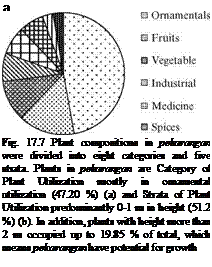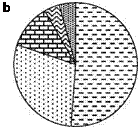The household number in each pekarangan is 4.6 persons, on average. The range of household members numbered from one to ten persons. The head of household most often was male (93.8 %); the rest of heads were women (6.3 %). The results showed that most respondents’ communities were more often patriarchates. The head of household averaged 48 years of age: the youngest was 22 years old and the oldest was 90 years old. Most (93.1 %) household heads had been married, mostly at 24 years of age, although among those the youngest one married at 13 years and the oldest at 63 years of age. In general, rural villages have productive age and potential human resources.
Nine occupation types found at the survey sites. Agricultural labor (26.4 %), particularly for members of G1, and farm-owned land (25.0 %), particularly for who hold OAL (G2 and G4), were the main occupation of the head of the household.
 |
 |
 |
Others had occupations in non-agriculture (13.2 %), as petty trader (4.2 %), housewife (4.2 %), driver (3.5 %), farmer of tenant land (1.4 %), and village official (0.7 %) and village elder (0.7 %), respectively. Remaining occupations (20.8 %) were a mix of many minor occupations. It can be concluded that the existence of agriculture-based occupations was prospective as initial capital for a development program.



